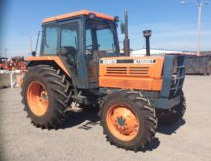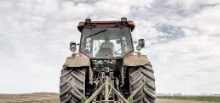________________________________________________________________________________________
Kubota M7950 Troubleshooting
 The
Kubota M7950 utility tractor was manufactured between 1983 and 1994. This model
has several variants: M7950F (2WD), M7950DT (4WD), M7950FW (Wide-tread),
M7950DTM (Mudder), and M7950HC (High-crop). The Kubota M7950 tractor is equipped
with a 262 cu.in (4.3 L) Kubota V4300 vertical 6-cylinder naturally aspirated
liquid-cooled diesel engine. The engine has a cylinder bore of 4.29" (109 mm),
piston stroke of 4.53" (115 mm), and rated power of 81 hp (60.4 kW). The fully
synchronized transmission consists of a single dry clutch and gearbox with 12
forward and 4 reverse gears.
The
Kubota M7950 utility tractor was manufactured between 1983 and 1994. This model
has several variants: M7950F (2WD), M7950DT (4WD), M7950FW (Wide-tread),
M7950DTM (Mudder), and M7950HC (High-crop). The Kubota M7950 tractor is equipped
with a 262 cu.in (4.3 L) Kubota V4300 vertical 6-cylinder naturally aspirated
liquid-cooled diesel engine. The engine has a cylinder bore of 4.29" (109 mm),
piston stroke of 4.53" (115 mm), and rated power of 81 hp (60.4 kW). The fully
synchronized transmission consists of a single dry clutch and gearbox with 12
forward and 4 reverse gears.
The maximum forward speed - 17.9 mph (28.8 kph), maximum reverse speed -
7.5 mph (12.1 kph). The open center hydraulic system has a gear pump
with a rated capacity of 11 gal/min (41.6 l/min). The hydraulic system
pressure is 181 bar (2630 psi). The two-wheel drive models are equipped
with 7.50x18 front tyres and 18.4x30 rear tyres. The 11.2x24 front tyres
and 18.4x30 rear tyres fit four-wheel drive tractors. The Kubota M7950
tractor can be equipped with the following attachments:
Kubota M1850A front-end loader
with a lift capacity to full height of 2630 lbs (1192 kg) and breakout
force of 4640 (2104 kg).
| Engine Troubleshooting |
| Engine will not start or hard to start |
| Plugged fuel filter - Replace the filter element |
| Closed fuel cock - Open fuel on-off cock to inject fuel |
| Fuel lines leaking air - Tighten clamps, change faulty pipes |
| Fuel injectors are clogged or faulty - Inspect fuel injectors and replace if necessary |
| Fuel injection pump malfunction - Repair or replace injection pump |
| Poor engine compression - Inspect cylinder block and replace worn components |
| Diesel shuts off during operation |
| Engine not warmed up - Normalize the engine temperature |
| Fuel lines leaking air - Tighten clamps, change faulty pipes |
| Uneven fuel injections - Repair or adjustment |
| Clogged fuel filter element - Replace the filter element |
| Fuel injectors are damaged or dirty - Clean or replace fuel injectors |
| Engine starts and immediately stops |
| Incorrectly set fuel injection pump timing - Adjust injection timing |
| Plugged fuel filter - Service the filter |
| Fuel injector nozzles are dirty or defective - Check and change nozzles as required |
| Fuel injection pump is damaged - Rebuild or replace pump |
| Dirty air cleaner - Replace or clean the air cleaner element |
| Engine stops while idling |
| Incorrect low idle speed adjustment - Correct low idle settings |
| Fuel injection pump is defective - Change or repair the pump |
| Fuel injector nozzles are clogged or faulty - Inspect injector nozzles and change if required |
| Valve clearance is not correct - Check and adjust as required |
| Insufficient coolant - Top up coolant. If there are leaks in the system, replace worn components |
| Cooling system components are failed or system is clogged - Flush cooling system or change faulty components |
| Insufficient engine oil - Fill the crankcase with engine oil |
| Broken fan belt or incorrect belt tension - Adjust belt tension correctly or replace it |
| Defective thermostat - Test thermostat opening temperature, replace as required |
| Dirty or faulty injectors - Change fuel injectors |
| Incorrect fuel injection pressure - Repair or replace injection pump |
| Air filter element clogging - Service or change air filter |
| Oil filter element is dirty - Change or service engine oil filter |
| Engine overload - Load reducing required |
| Valve clearance is wrong - Correct valve clearance |
| Incorrect low idle speed adjustment - Normalize low idle speed |
| Clogged fuel hoses or pipes - Clean fuel system pipes and hoses |
| Insufficient engine compression: Worn or damaged valves - Replace the valves |
| Abnormal engine knocking or noise |
| Timing of fuel injection pump is wrong - Fuel injection pump timing adjustment needs to be corrected |
| Faulty fuel injector nozzles - Inspect injector nozzles and change if required |
| Not enough engine oil - Check and refill engine oil |
| Engine is not fully warmed up - Warm up engine as required |
| Worn main bearings or crankshaft - Worn parts replacement required |
| Damaged or defective piston rings - Piston rings need to be replaced |
| Flywheel mounting screws are loose - Tighten the screws |
| High engine oil consumption |
| Oil leakage: Damaged gaskets or seals - Change to repair leaks |
| Oil viscosity is wrong - Use oil of correct viscosity |
| Stuck or defective piston rings - Piston rings replacement required |
| Worn valve stems and valve guides - Replace the valves |
| Cylinder liners or pistons are scuffed - Inspect pistons and liners, fit new components as necessary |
| Electrical System Troubleshooting |
| Battery does not charge |
| Battery is worn - Use a new battery |
| Battery wiring harness damage - Inspect battery wiring for damage, replace or repair |
| Loose or corroded terminals and cables - Tighten or service terminals and cables |
| Defective belt or improperly adjusted belt tension - Adjust belt tension as required or replace belt |
| Low battery output - Battery is drained, charge it |
| Battery won’t hold charge - Service charging system or install new battery |
| Battery electrical wire harness damage - Check battery wires for damage, replace or change |
| Corroded or loose terminals and cables - Tighten or service terminals and cables |
| Low battery output voltage - Charge the battery |
| Discharged or worn battery - Recharge or change battery |
| Starter motor failure - Repair or change starter |
| Wiring harness is disconnected or improperly connected - Check wiring harness and reconnect properly |
| Transmission Troubleshooting |
| Gears are hard to shift |
| Clutch is not adjusted or faulty - Clutch adjustment or replacement required |
| Gear shift linkage is loose or broken - Change or repair shift linkage |
| Shift forks are worn or damaged - Replace the shift forks |
| Faulty parts in the gear shifting mechanism - Change faulty parts |
| Low transmission oil pressure |
| Not enough oil in transmission - Correct the transmission oil level |
| Clogged transmission oil filter (if equipped) - Change or service the transmission oil filter |
| Relief valve is faulty - Replace relief valve |
| Bearings are worn or damaged - Replace faulty bearings |
| Low transmission oil level - Add transmission oil as required |
| Contaminated transmission fluid - Transmission fluid must be changed |
| Defective gears or incorrect backlash - Replace gears or set backlash properly |
| Bent or worn shift forks - Shift forks need to be changed |
| Transmission fluid leakage |
| Broken gaskets or seals - Install new seal or gaskets |
| Cracked transmission housing - Housing needs to be replaced |
| Hydraulics Troubleshooting |
| Hydraulic system is overheated |
| System pressure has not been adjusted correctly - Pressure needs to be adjust correctly |
| Main relief valve malfunction or incorrect adjustment - Adjust relief valve or change if required |
| Hydraulic fluid is contaminated - Fill up with new hydraulic fluid |
| Air enters in hydraulic system - Inspect the suction pipe, fittings, and pump seals |
| Low hydraulic system pressure |
| Hydraulic fluid level is low - Check and refill the hydraulic fluid |
| Hydraulic oil filter clogging - Hydraulic filter maintenance required |
| Defective hydraulic pump - Check pump capacity and change if necessary |
| Hydraulic spool valve is not set properly or defective - Replace or adjust properly |
| Hydraulic cylinder is not working - Inspect cylinder parts for wear or damage and replace if required |
| Hydraulic pipes are leaking - Identify leaks in the system and repair it |
| 3-point hitch raises slowly or won't raise |
| Hydraulic fluid level is low - Fill the hydraulic system with oil |
| Cold hydraulic fluid - Warm up the fluid |
| Hydraulic oil filter element clogging - Service or replace the hydraulic filter |
| Damaged hydraulic oil pump - Check pump performance and change it if necessary |
| Defective or misadjusted main relief valve - Adjust relief valve or change if required |
| Hydraulic control valve block is not set properly or defective - Change or adjust correctly |
| Hydraulic cylinder is broken - Check the hydraulic cylinder components for damage or wear and change if necessary |
| Suction pipe is damaged or loose - Repair or change |
| 3-point hitch fails to drop or drops slowly |
| Hydraulic spool valve block is faulty or out of adjustment - Change or adjust properly |
| Hydraulic cylinder is defective - Check cylinder parts for wear or damage and replace if necessary |
| Lift arm shaft is damaged - Change the shaft |
| Mechanical parts of the hitch are damaged - Change defective or worn hitch parts |
| Hitch jerks when lower or lift |
| Air leaks in hydraulic system - Check the pump seals, suction pipe, and fittings |
| Dirty hydraulic oil - The oil must be changed |
| Defective hydraulic pump - Flow-rate pump and change pump if necessary |
| Hydraulic control valve block is defective or set improper - Adjust correctly or replace |
| Hydraulic cylinder failure - Check the hydraulic cylinder components for damage or wear and change if necessary |
________________________________________________________________________________________
________________________________________________________________________________________
| Farm Tractors Technical Specifications |
 The
Kubota M7950 utility tractor was manufactured between 1983 and 1994. This model
has several variants: M7950F (2WD), M7950DT (4WD), M7950FW (Wide-tread),
M7950DTM (Mudder), and M7950HC (High-crop). The Kubota M7950 tractor is equipped
with a 262 cu.in (4.3 L) Kubota V4300 vertical 6-cylinder naturally aspirated
liquid-cooled diesel engine. The engine has a cylinder bore of 4.29" (109 mm),
piston stroke of 4.53" (115 mm), and rated power of 81 hp (60.4 kW). The fully
synchronized transmission consists of a single dry clutch and gearbox with 12
forward and 4 reverse gears.
The
Kubota M7950 utility tractor was manufactured between 1983 and 1994. This model
has several variants: M7950F (2WD), M7950DT (4WD), M7950FW (Wide-tread),
M7950DTM (Mudder), and M7950HC (High-crop). The Kubota M7950 tractor is equipped
with a 262 cu.in (4.3 L) Kubota V4300 vertical 6-cylinder naturally aspirated
liquid-cooled diesel engine. The engine has a cylinder bore of 4.29" (109 mm),
piston stroke of 4.53" (115 mm), and rated power of 81 hp (60.4 kW). The fully
synchronized transmission consists of a single dry clutch and gearbox with 12
forward and 4 reverse gears. 